 |  |
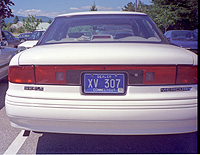 These plates are issued to new car dealers who are operating under a manufacturer's or importer's contract. These plates are issued to new car dealers who are operating under a manufacturer's or importer's contract.
The plates are to be used for demonstrating new vehicles, on vehicles picking-up or delivering parts, or loaned to a purchaser while a pending registration is being processed. Full-time dealership employees are also allowed use of these plates for personal use.
This type started in 1907. The plates were the reverse colors of passenger car plates and had a 'D' suffix from 1907 to 1916. Starting in 1917 an 'X' prefix was used and the plates were the same colors as regular passenger car plates. Eventually a second letter was used after the 'X'. In 1932, stacked letters were used as a prefix. Sometime after this, the 'D' and 'X' series were split.
In 1942, the distinction was made between "New Dealer" and "Used Dealer" on the plates themselves. New Car Dealers used the 'X' prefix, and 'D' went to used dealers.
At this time, dealers would receive a "distinguishing number", for example "X234". The dealership would then receive plates XA 234, XB 234, XC 234 and so on. XQ- and XZ- are skipped, making the complete set 24 plates.
1957 saw the introduction of standard-sized 6x12 Dealer plates. 'New' and 'Used' were no longer spelled out on the plates; they are only distinguished by the first letter.
Starting in 1961, dealer plates became annual issues - the plates were replaced every year. The colors were blue on white for odd years, and white on blue for even years. This practice continued through 1980. The year of expiration was stamped into the plate.
|
 |
 |
1913
Dealer plates started in 1907, in reverse colors of regular passenger car plates, and with a 'D' suffix.
This plate was issued to Edward Wetmore of Roxbury. |
1915. This plate was issued to Hepburn Bros. on Bridge St. in New Milford |
| |
|
 |
 |
1917
In 1917, the 'D' suffix was changed to an 'X' prefix. |
1918 |
| |
|
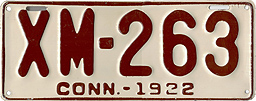 |
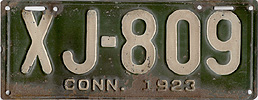 |
1922
This is probably as nice as you will ever find one of these plates - the paint is all original; the plate was never used. |
1923 |
| |
|
 |
 |
1937
The Dealer legend became more specific in 1942, denoting whether the dealer sold New or Used vehicles. |
1938 |
| |
|
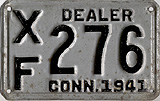 |
|
| 1941 |
|
| |
|
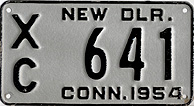 |
 |
1954
|
1957
There are a couple of curious plates on the '54-'56 base with a letter suffix after the numbers. For use at very large dealerships?
|
| |
|
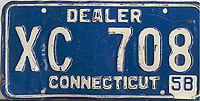 |
 |
| 1958 |
1960 |
| |
|
 |
 |
1961
Dealer plates reversed in color every year through 1979. While dealer plates were one of the few types dated 1961 in Connecticut, 1961 dealer plates are not any rarer than any other year dealer plate.
|
1962 |
| |
|
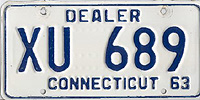 |
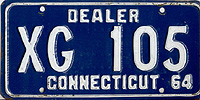 |
| 1963 |
1964 |
| |
|
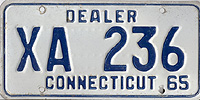 |
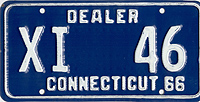 |
| 1965 |
1966 |
| |
|
 |
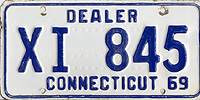 |
| 1967 |
1969 |
| |
|
|
|
|
